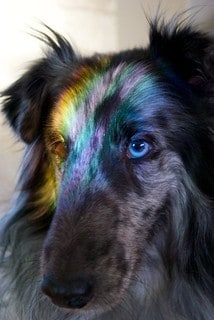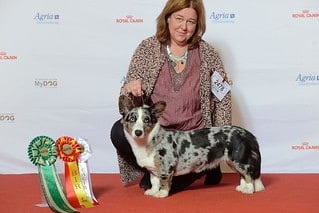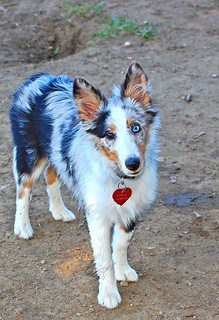
blue eyes
There is a strange thing about blue eyes in dogs.
The overwhelming majority of adult dogs don’t have blue eyes, they have brown eyes.
But all dogs are born with blue eyes. Did you know that?
But by the time that most dogs are three or four months old, their eyes will be some shade of brown.
There are 5 breeds of small dogs registered with the American Kennel Club where blue eyes are acceptable, or included in the breed standard to use “official speak”.
These breeds are:
- American Hairless Terrier
- Cardigan Welsh Corgi
- Dachshund
- The Shetland Sheepdog
- Hungarian Mudi
In addition to these four registered breeds, there are another two recognised small breeds that are not registered:
- Alaskan Klee Kai
- Miniature American Shepherd
There are also six breeds of dogs where the breed standard states that if a dog is presented at a show with blue eyes it will lead to an automatic disqualification.
And these are:
- American Eskimo Dog
- Cocker Spaniel
- Cirneco dell’Etna
- Pembrokeshire Welsh Corgi
- Rat Terrier
- Russell Terrier
Why do dogs have blue eyes?
According to Dog Genetics, there are four ways that dogs can have blue eyes.
They are:
- Side effect of the merle gene
- When a dog has a large amount of white around their eyes.
- Albinism
- Blue eyes are a separate gene
The merle gene
Merle is a genetic pattern, involving the loss of pigment, in a dog’s coat.
It results in a speckled or blotchy coat colour.
It can affect any coat colour and the pattern will either result in a red or blue merle.
As well as the colour of the coat (and the eyes) being affected, it can also lead to pink noses and pink paws.
Blue eyes are a separate gene
A recent study in 2018 revealed that some dogs have a specific gene that causes their eyes to turn blue.
The study involved the DNA samples of over six thousand dogs and it found that a duplication of a chromosome near the ALX4 gene will cause a dog’s eye to be blue.
Even in dogs without a merle pattern, such as some varieties of the Australian Shepherd dog.
Health conditions associated with merle coats and blue eyes
Whilst it is easy to see why having a “merle” dog is a very attractive prospect, the merle gene can cause blindness and deafness in dogs.
This happens when two merle dogs are mated together.
The Kennel Club (the UK based organisation responsible for protecting and promoting the health and welfare of all dogs) started to ban merle to merle mating in specific breeds as early as 2012.
This included Chihuahuas, Bulldogs and Border Collies.
In January 2020, The Kennel Club issued a wider ban on registering all merle dogs from breeds that don’t have a significant history of the colour in the breed.
Health conditions associated with a dog’s eyes suddenly turning blue
Puppies’ eyes are blue
As I have already said, all puppies are born with blue eyes.
Puppies eyes are closed up until they are ten days old.
Once open their eyes are blue.
Over the next three months, the eyes will change bit by bit to a brown colour..
This is a natural process that you shouldn’t worry about.
All of the other conditions that I mention below will require an urgent trip to the vets.
Interstitial Keratitis
This condition is called blue eye and it is very painful.
It happens when the cornea becomes inflamed and the eye turns blue.
It can be caused by a fungus or bacteria or via trauma, such as the eye being scratched.
Nuclear Sclerosis
This is a natural part of the aging process when the lens in a dog’s eye may turn a hazy blue.
It doesn’t seem to affect the quality of vision much and it is a different condition to cataracts.
Other health conditions associated with a dog’s eyes can lead to them turning cloudy, with a bluish tint to them.
These include cataracts and glaucoma.
5 small dogs where blue eyes are acceptable
I will use the AKC’s ranking system, which ranks the popularity of each registered breed as a countdown, starting with the least popular.
Hungarian Mudi
Although this is a registered breed with the AKC, it is so rare that it has no ranking because there were no Mudis that were registered in the past year!
In fact, they are so rare that I’m struggling to get a photo of one!
Perhaps only numbering a few thousand most of whom are based in Hungary, followed by Finland.
They are very rare in the rest of Europe or the U.S.
With a height range of between 38 cm (15”) to 45 cm (18”) perhaps this is a touch too big to be included in a list of small dogs, but it is a blue eyed breed and a rare breed and so I was a bit intrigued.
Weight wise, these dogs range between 8 kg (18 lbs) to 13 kg (29 lbs.)
This Hungarian breed of dog has been used to herd cattle and sheep and also to protect property on farms
This breed comes in a variety of colours. These include: black, brown, gray, gray-brown, yellow and white.
A merle pattern is acceptable with any of these colours.
Dogs that are yellow and white are can have blue eyes or brown speckled with blue eyes.
[2] American Hairless Terrier

colouring ²
The American Hairless Terrier was developed in Louisiana.
It comes in two varieties- hair and hair less.
The variety without hair might have hair on their eyebrows and have some whiskers.
The variety with hair has a coat of shiny but short hair.
In terms of their size, they can stand between 30cm (12”) and 40 cm (16”) and their range in weight between 5 kgs (12 lbs) and 7 kg (16 lbs.)
When it comes to eye colour, blue eyes are acceptable in dogs that are blue coloured or blue fawn colour but grey eyes is the preferred colour for these varieties.
These dogs, like most terriers, have a strong hunting instinct but their lack of hair makes them very unsuitable for any type of hunting.
Instead, their large physical and mental energies should be channeled via activities such as agility.
[3] Cardigan Welsh Corgi

blue eyes ³
Do you fancy owning a blue eyed Corgi, much loved by Queen Elizabeth II?
Well, you can’t because she owns Pembrokeshire Welsh Corgis and they are different to their Cardigan cousins.
But these are still great dogs.
And blue eyed Pembrokeshire Corgis aren’t allowed by the AKC but blue eyed Cardigan Corgis are.
And this can include a dog that has two blue eyes or one blue and one brown eye or two eyes that are partially blue.
But only if they have a merle coat.
Other coat colours include: red (or course), sable, brindle or black.
A Cardigan Welsh Corgi will stand between 26 cm 10.5” and 31 cm (12.5”) tall and a male can weigh anything up to 17 kg (38 lbs.)
No wonder these dogs are described as “sturdy boned”!
Cardigans were originally bred to herd cattle, where being so small meant that the cows accidentally kick them less often.
They are a terrifically loyal dog who are flexible enough to thrive as both a companion animal or a hard worker.
[4] Dachshund

Dachshunds are very popular dogs.
Currently they are ranked twelfth most popular breed according to the AKC.
And there is something very attractive about a dog that has such strange proportions- long ears, long neck, long body but short legs.
Here are two quotes which I think sum up the most important qualities about Dachshunds.
Robert Benchley once said that “Dachshunds are ideal dogs for small children, as they are already stretched and pulled to such a length that the child cannot do much harm one way or the other.”
And Queen Victoria once said “Nothing will turn a man’s home into a castle more quickly than a Dachshund.” This was a great insight into a Dachshund’s fierce loyalty to their owners.
Dachshunds come in lots of different “flavours”.
As well as coming in two different sizes (miniature and standard), Dachshunds come with three different hairstyles: smooth, wirehaired and long haired.
And there are lots of different colour combinations and blue eyes (or partially blue eyes) are only acceptable in “dappled” Dachshunds.
[5] The Shetland Sheepdog (Sheltie)

Do you fancy owning a blue eyed mini version of “Lassie”?
Well, Lassie was a Rough Collie: and true miniature versions don’t really exist.
But the Sheltie would come a close second.
Shelties have three possible colours- black, blue merle and sable.
And blue eyes are only acceptable in blue merles.
Other colours of Shelties must have dark eyes.
Shelties have wonderful personalities and physical prowess.
They are an easy dog to train, they love family life and they excel in events such as agility.
In terms of size, they stand 32cm (13”) to 37cm (16”) high and weigh on average around 20 lbs (9 kgs.)
One of the only downsides can be how noisy they can be- they love to bark!
5 small dogs where blue eyes are banned
The American Kennel Club or the Kennel Club have a responsibility for the welfare of dogs.
Because there are real dangers in blue eyed dogs (merle coloured) dogs breeding with each other, the AKC have explicitly identified 6 breeds where blue eyes will lead to an automatic disqualification in any of their dogs shows.
Now, the AKC recognises one hundred and ninety six different breeds of dogs and so this ban on just six breeds might seem tokenistic.
I would think that these six breeds are the biggest cause for concern in terms of trying to maintain safe breeding standards.
And here are the six breeds and for each one, I have provided a link with the breed standard.
[1] American Eskimo Dog
You can find the breed standard here. There is a section explicitly about eyes.
[2] Cocker Spaniel
You can find the breed standard here. There is a section explicitly about eyes.
[3] Cirneco dell’Etna
You can find the breed standard here. There is a section explicitly about eyes.
[4] Rat Terrier
You can find the breed standard here. There is a section explicitly about eyes.
[6] Russell Terrier
You can find the breed standard here. There is a section explicitly about eyes.
Closing Thoughts
I hope that you have enjoyed reading about small dogs and blue eyes and that you have found your perfect “+1” in the list of breeds where the AKC deem blue eyes to be acceptable.
If you can, steer clear of any of the breeds on AKC’s banned for the sake of the breed and perhaps yourself in terms of future heartbreak.
Of course, after all of this you might have changed your mind and ditched your plan for a small dog with blue eyes in favour of getting a “blue eyed” poster boy- the Siberian Husky.
I wish you many happy hours gazing into your dog’s eyes…
Photo Credits
¹ Photo by Derek Gavey on Flickr
² Photo by John Morton on Flickr
³ Photo by Svenska Massan on Flickr
⁴ Photo by Lou Liebau on Unsplash
⁵ Photo by Steve @ the alligator farm on Flickr





